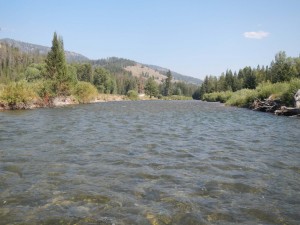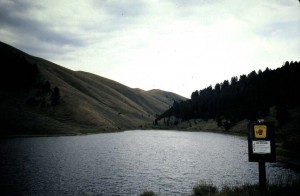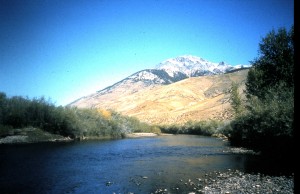Grey’s River

Whether you intend to visit this area or if you reside nearby, put the Grey’s River on your “have to try” list for next August and/or September. Without a doubt, this western Wyoming river is one of the most beautiful high country rivers on earth. Mostly of moderate gradient, it flows mainly through pine forests but has some meadow reaches especially in upstream locations. Once you get to Alpine Wyoming via either US highway 89-91 or US Highway 26, look for the Grey’s River Road heading east out of “downtown” Alpine. If you need a Wyoming license, fly-fishing gear, accommodations, or a good meal, Alpine can serve you well. Back to the Grey’s River road. Just the drive along it is worth a trip, and not having a good camera in possession is a tragedy. For better than forty miles the Grey’s River Road parallels the river which at times is a stone’s throw away, then other times out of sight. It is one of the better maintained gravel roads anywhere. Along the road, mostly in its middle reaches, are some of the best US Forest Service campgrounds that can be found. These make great locations for anglers wishing to stay within casting range for days to enjoy fishing the river. With exception of a few large ranches, the river courses through Bridger-Teton National Forest. Thus access is not problem.
The Grey’s drains the country between the Wyoming Range and the Salt River Range. It’s beginnings are above elevation 6000 feet and no where is it below 5000 feet. All this makes it a run-off stream of major proportions. That’s why we cannot recommend fishing it until around late July in normal run-off years. So let’s look at what this river offers with respect to fishing. Snake River fine spotted cutthroat trout and mountain whitefish are the natives. In the lower reaches one can encounter a few brown trout. I use to believe that a sixteen inch cutt would be a braggin’ fish from the Grey’s. Was I ever wrong! After concentrating a few years back on some undercut banks with ant patterns, I nailed a couple of eighteen inch guys. LeRoy, one of my fishing buddies did even better by fooling a twenty-two inch beauty. Another prime place to concentrate attention would be where willows overhang a deeper run. Fish residing here have “double cover” from depth and the overhang. So laying here looking for drifting food items gives them comfort. If you fish early in the late July time frame, you may see golden stoneflies emerging and cutts sipping them. About the same time PMDs will begin a summer-long emergence and attract fish with their activity. Afternoons will be the best time to enjoy the PMDs because, as with all “non-tailwater” high country rivers, time is required for water to warm up to their activity levels. Caddisflies are plentiful all along the river, and some late afternoon swarms can invade your eyes, ears, nose, and throat. In the September time frame tricos will make for some morning fishing, but generally afternoon to early evening are the best times for dry fly fishing. Presenting nymph patterns can be good throughout the day.
Here’s a couple of thoughts to consider for the Grey’s River. Below the Little Grey’s River confluence the river flows at a higher gradient through a canyon beloved by local kayakers and rafters down to near the confluence with the Snake River (beneath the topmost part of Palisades Reservoir early in the season). Further upstream above the Murphy Creek Bridge fishing is permitted with artificial flies and lures only. Throughout this reach the river can be waded with care. The bottom consists mostly of rocks and cobbles. You might encounter a few drift boats or rafts on the river above Murphy Creek bridge, but that is only a once in a while happening. Afternoon thundershowers are always possible here, and heavy ones can discolor the river to a coffee and cream color. But normally the Grey’s River runs as clear and sparkling as any stream can. If you decide to give the Grey’s a try, don’t forget that camera!



